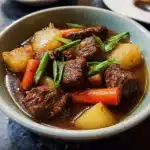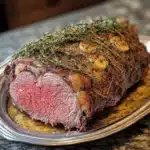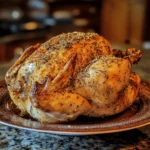There are classic comfort foods, the ones that feel like a direct line to our collective culinary soul—a thick, hearty beef stew is undoubtedly one of them. It’s the taste of a chilly Sunday, the promise of warmth and sustenance simmered low and slow. For years, that was the only beef stew I knew: a rich, gravy-like broth thick with flour, studded with potatoes and carrots, a recipe passed down and perfected. But then, a journey, a discovery, and a series of kitchen experiments led me to a different kind of comfort, a stew that possessed the same soul-warming depth but spoke with an entirely different, more vibrant accent. This is the story of my Asian-Inspired Beef Stew.
My love for the complex, layered flavors of Asian cuisine—the delicate dance of salty, sweet, sour, and savory—has always been a driving force in my cooking. I found myself wondering, what if I could infuse the slow-cooked, tenderizing magic of a Western-style stew with the bold, aromatic personality of my favorite Asian dishes? What if I could replace the simple salt and pepper with the umami depth of soy sauce, the bay leaf with a fragrant star anise, and the thyme with the warm spice of fresh ginger? It was a culinary “what if” that I couldn’t ignore.
The first time I attempted this fusion, the process itself felt like an act of creation. The kitchen began to fill not with the familiar scent of a simple beef roast, but with an intoxicating perfume that was entirely new. The sharp, clean scent of ginger and garlic hitting hot oil, the rich, malty aroma of Shaoxing wine deglazing the pan, and then, the star of the show, the heady, licorice-like fragrance of star anise blooming in the simmering broth. It was a scent that promised both the deep comfort of a stew and the excitement of a new adventure. As the hours passed, the tough cut of beef surrendered, becoming impossibly tender, bathed in a broth that was dark, glossy, and profoundly flavorful. I served it over a simple bowl of steamed rice, the grains eagerly soaking up the complex, savory-sweet liquid. The first bite was a revelation. It was everything I loved about a classic beef stew—the fall-apart tender meat, the satisfying warmth—but elevated, transformed into something more dynamic, more fragrant, more alive. It has since become a treasured recipe in our home, a modern classic that proves comfort food knows no borders.
Complete with the ingredients amount
This Asian-Inspired Beef Stew is a symphony of flavors, built upon a foundation of classic stewing techniques but infused with the iconic tastes of East Asian cuisine. The recipe is designed for a large Dutch oven or heavy-bottomed pot and yields about 6-8 hearty servings, making it perfect for a family meal or for delicious leftovers.
For the Beef and the All-Important Sear:
- Beef Chuck Roast: 3 pounds, boneless. Chuck roast is the ideal cut for stewing. It’s a tougher, well-marbled cut that becomes incredibly tender and flavorful when cooked low and slow. Trim any excessive large pieces of fat and cut the beef into generous 1.5- to 2-inch cubes.
- Vegetable Oil or other Neutral Oil: 2 tablespoons. For searing the beef.
- Salt and Black Pepper: For seasoning the beef before searing.
For the Aromatic Braising Liquid (The Flavor Core):
- Yellow Onion: 1 large, chopped.
- Shallots: 2 large, thinly sliced. The combination of onion and shallot provides a complex, sweet aromatic base.
- Garlic: 8 cloves, smashed and roughly chopped. Smashing the cloves before chopping helps to release more of their essential oils.
- Fresh Ginger: A 3-inch piece, peeled and cut into thick coins or slices. This infuses the broth with a warm, spicy flavor without leaving small, fibrous bits in the final stew.
- Shaoxing Wine (or Dry Sherry): ½ cup. This Chinese cooking wine is essential for deglazing the pan and adding a complex, fragrant depth. Dry sherry is the best substitute.
- Low-Sodium Beef Broth: 4 cups. Using a low-sodium broth allows you to control the final saltiness of the stew, which is important when also using soy sauce.
- Low-Sodium Soy Sauce: ½ cup. Provides the primary umami and salty flavor. For a gluten-free option, use Tamari.
- Dark Soy Sauce (optional): 1 tablespoon. This is less about saltiness and more about color and a hint of molasses-like flavor, giving the stew its rich, dark, glossy appearance.
- Brown Sugar: 2 tablespoons, packed. Adds a touch of sweetness to balance the salty and savory elements.
- Toasted Sesame Oil: 1 tablespoon. This is added at the end, off the heat, for its powerful, nutty aroma.
- Whole Spices for Infusion:
- Star Anise: 2 whole pods. The signature aromatic of the dish, providing a warm, licorice-like fragrance.
- Cinnamon Stick: 1 (3-inch) stick. Adds a subtle, warm sweetness.
For the Hearty Vegetables:
- Carrots: 4 medium, peeled and cut into large, 1-inch chunks.
- Daikon Radish: 1 medium (about 1 pound), peeled and cut into large, 1-inch chunks. Daikon becomes tender and slightly sweet when cooked, absorbing the flavor of the broth beautifully.
- Dried Shiitake Mushrooms: 1 ounce (about 8-10 mushrooms). Dried shiitakes provide an intense, smoky umami flavor that is far more potent than fresh mushrooms.
For the Finishing Touches and Garnish:
- Baby Bok Choy: 4-6 heads, ends trimmed and halved lengthwise. This tender green is added at the very end to be gently wilted.
- Green Onions (Scallions): 4, thinly sliced, for garnish.
- Toasted Sesame Seeds: For garnish.
- Fresh Cilantro: A handful of fresh leaves, for garnish.
Instructions
This stew is a labor of love, but most of the work is passive simmering time. The active steps are focused on building deep layers of flavor right from the start.
Step 1: Prepare the Ingredients
Before you begin, undertake your “mise en place.” Cut the beef into cubes, chop all your aromatics and vegetables, and measure out your liquids and spices. Reconstitute the dried shiitake mushrooms by placing them in a bowl and covering them with 2 cups of very hot water. Let them soak for at least 30 minutes. Once softened, lift the mushrooms out of the liquid (reserving the flavorful soaking liquid), gently squeeze out any excess water, trim off and discard the tough stems, and slice the caps. Strain the reserved mushroom soaking liquid through a fine-mesh sieve or a coffee filter to remove any grit, and set it aside.
Step 2: Sear the Beef to Perfection
Pat the beef cubes thoroughly dry with paper towels. A dry surface is essential for getting a good brown crust. Season the beef generously on all sides with salt and freshly ground black pepper.
Place a large, heavy-bottomed Dutch oven or pot over medium-high heat. Add the 2 tablespoons of vegetable oil. Once the oil is hot and shimmering, carefully add the beef cubes to the pot in a single layer. Do not overcrowd the pan. If necessary, do this in two or three batches. Let the beef sear, undisturbed, for 3-4 minutes per side, until a deep, brown crust forms. A proper sear is the foundation of the stew’s flavor. Transfer the seared beef to a clean plate and set aside.
Step 3: Build the Aromatic Base
Reduce the heat to medium. To the same pot, add the chopped onion and sliced shallots. Sauté for 5-7 minutes, scraping the bottom of the pot with a wooden spoon, until the onions have softened and turned a light golden brown, picking up all the flavorful browned bits (fond) from the beef.
Add the smashed garlic and sliced ginger to the pot. Cook for another 2 minutes, stirring constantly, until they are very fragrant.
Step 4: Deglaze and Create the Braising Liquid
Pour the ½ cup of Shaoxing wine (or dry sherry) into the pot. As it bubbles, continue to scrape the bottom of the pot vigorously to release any remaining browned bits. Let the wine simmer until it has reduced by about half.
Add the seared beef (and any accumulated juices from the plate) back into the pot. Pour in the 4 cups of beef broth, the ½ cup of soy sauce, the optional 1 tablespoon of dark soy sauce, the packed brown sugar, and the reserved shiitake mushroom soaking liquid. Stir everything together.
Tuck the 2 whole star anise and the cinnamon stick into the liquid. Bring the stew to a boil, then immediately reduce the heat to the lowest possible setting that will maintain a very gentle simmer.
Step 5: The Long, Slow Simmer
Cover the pot with a tight-fitting lid and let the stew simmer gently for 1 ½ to 2 hours. The key is a low, slow simmer—you should only see a few lazy bubbles breaking the surface. This gentle cooking method is what breaks down the tough connective tissues in the chuck roast, making it incredibly tender.
Step 6: Add the Vegetables
After the initial simmer, add the hearty vegetables to the pot: the chopped carrots, the chunked daikon radish, and the sliced, rehydrated shiitake mushrooms. Stir them gently into the stew.
Place the lid back on the pot and continue to simmer for another 45 minutes to 1 hour. The stew is ready when the beef is fall-apart tender (you should be able to easily shred it with a fork) and the carrots and daikon are completely cooked through and tender.
Step 7: The Finishing Touches
Fish out and discard the star anise pods, the cinnamon stick, and the large pieces of ginger.
Stir in the 1 tablespoon of toasted sesame oil. This is added off the heat to preserve its delicate, nutty aroma.
Add the halved baby bok choy to the pot. Gently push them down into the hot broth. Place the lid back on the pot and let it sit for just 5 minutes. The residual heat is more than enough to perfectly wilt the bok choy, leaving it tender but still with a vibrant green color and a slight crunch.
Step 8: Serve and Garnish
Taste the broth and adjust for seasoning if necessary, though it should be well-seasoned from the soy sauce. Ladle the hot stew into large, warm bowls, making sure to get a good distribution of beef, vegetables, and the rich broth.
Garnish generously with a sprinkle of thinly sliced green onions, toasted sesame seeds, and a few leaves of fresh cilantro. Serve immediately.
Nutrition Facts (Servings and calories per serving)
This Asian-Inspired Beef Stew is a hearty and nutrient-dense meal. The nutritional information is an estimate and can vary based on the exact cut of beef and other specific ingredients.
- Servings: This recipe yields approximately 6 to 8 servings.
- Calories per serving: Approximately 500 to 650 calories.
This dish is an excellent source of high-quality protein, iron, and zinc from the beef. The long, slow cooking process helps to make the nutrients more bioavailable. The variety of vegetables, from the carrots and daikon to the bok choy and mushrooms, provides a good source of fiber, vitamins (like Vitamin A and C), and minerals.
Preparation time
While this stew requires a significant amount of time to cook, the vast majority of it is hands-off, passive simmering time, making it a perfect weekend or lazy day cooking project.
- Active Preparation Time: 30 minutes. This includes cubing the beef, chopping the vegetables, and searing the meat.
- Cook Time: 3 to 3.5 hours. This is the crucial, low-and-slow simmering time.
- Total Time: Approximately 3 hours and 30 minutes to 4 hours.
How to Serve
The rich, brothy nature of this stew lends itself to a variety of serving styles, each one delicious.
- Over Steamed Rice: This is the classic and most satisfying way to serve the stew. A bed of fluffy, short-grain white rice is the perfect neutral canvas, eagerly soaking up the deeply flavorful broth.
- With Noodles: Ladle the stew over a bowl of thick, chewy udon noodles or bouncy ramen noodles for an incredibly hearty and comforting meal.
- As a Standalone Stew: This stew is so packed with meat and vegetables that it can absolutely be enjoyed on its own in a deep bowl with a spoon.
- With Crusty Bread: While not traditional, a warm, crusty baguette or a piece of sourdough is a fantastic, fusion-style accompaniment, perfect for sopping up every last drop of the incredible broth.
- Garnishes are Non-Negotiable: The final garnishes are essential for adding freshness and textural contrast to the long-simmered stew. The sharp bite of the green onions, the nutty crunch of the sesame seeds, and the bright, herbaceous notes of cilantro wake up the entire dish.
Additional tips (5 tips)
These five professional tips will help you perfect the nuances of this stew, ensuring a result that is deeply flavorful, incredibly tender, and truly memorable.
- Don’t Skip the Sear—It’s the Flavor Foundation: Searing the beef until it has a deep, dark brown crust is the single most important step for developing complex flavor. This process, the Maillard reaction, creates hundreds of new flavor compounds that water-based simmering alone cannot achieve. Be patient, use a hot pan, don’t overcrowd it, and do it in batches. The glorious brown bits (fond) left in the bottom of the pot are pure gold.
- Low and Slow is the Unbreakable Tempo: The secret to transforming a tough cut of meat like chuck roast into something meltingly tender is not high heat, but time and gentle moisture. A low, slow simmer (where you only see a bubble or two breaking the surface) allows the tough collagen and connective tissue in the meat to slowly break down and melt into rich, silky gelatin. If you boil the stew, the muscle fibers will seize up and become tough, no matter how long you cook it.
- Harness the Power of Dried Mushrooms (and Their Liquid): While you can use fresh mushrooms, dried shiitake mushrooms are a secret weapon for adding an unparalleled depth of savory, smoky umami to the broth. The real pro move is to reserve the liquid used to rehydrate them. This “mushroom tea” is packed with flavor. Just be sure to strain it through a coffee filter or fine-mesh sieve to remove any grit before adding it to your stew.
- Finish with Flavor—Off the Heat: The most delicate and volatile aromas can be lost during a long simmer. That’s why the toasted sesame oil is added at the very end, after the heat has been turned off. This preserves its powerful, nutty fragrance, ensuring it’s one of the first things you smell and taste. Similarly, the fresh garnishes (scallions, cilantro) are added just before serving to provide a bright, fresh contrast to the rich, deep flavors of the stew.
- Make It a Day Ahead for Even Better Flavor: Like most stews and braises, this Asian-Inspired Beef Stew is even better the next day. An overnight rest in the refrigerator allows the flavors to meld, deepen, and become even more complex and cohesive. It’s the perfect dish to make on a Sunday for a spectacular and stress-free Monday night dinner. When reheating, do so gently on the stovetop over low heat.
FAQ section (5 Q/A)
Here are the answers to some of the most frequently asked questions about making this delectable and comforting stew.
Q1: What are the best cuts of beef to use for this stew?
A1: The best cuts are tougher, collagen-rich cuts from the shoulder or leg of the cow. Boneless beef chuck is the most popular and ideal choice; it has a great balance of meat and fat and becomes incredibly tender. Other excellent options include bottom round roast, brisket (specifically the point cut), or even bone-in short ribs, which will add even more richness to the broth from the bones and marrow. Avoid lean, tender cuts like sirloin or tenderloin, as they will become dry and tough with this long cooking method.
Q2: Can I make this stew in a slow cooker or an Instant Pot?
A2: Yes, absolutely! This recipe adapts beautifully to both appliances.
- For a Slow Cooker: Perform steps 2, 3, and 4 (searing the beef, sautéing the aromatics, and deglazing) in a skillet on the stovetop. Then, transfer the seared beef and the sauce mixture to your slow cooker. Add the broth, soy sauce, sugar, and whole spices. Cook on LOW for 6-8 hours or on HIGH for 4-5 hours. Add the hearty vegetables (carrots, daikon, mushrooms) during the last 2 hours of cooking on LOW, or the last hour on HIGH. Add the bok choy and sesame oil during the last 15 minutes.
- For an Instant Pot: Use the “Sauté” function to perform steps 2, 3, and 4 directly in the Instant Pot insert. After adding the beef back and all the braising liquids, secure the lid and cook on HIGH pressure for 35 minutes. Let the pressure release naturally for 15 minutes, then manually release the remaining pressure. Add the hearty vegetables, secure the lid again, and cook on HIGH pressure for another 10 minutes, followed by a quick release. Stir in the bok choy and sesame oil on the “Keep Warm” setting.
Q3: I can’t find Shaoxing wine. What is a good substitute?
A3: While Shaoxing wine has a unique flavor, there are several excellent substitutes. The best and most readily available substitute is dry sherry. You could also use Japanese sake. If you prefer to cook without alcohol, you can simply substitute the wine with an equal amount of additional low-sodium beef broth. If you do this, you may want to add a teaspoon of rice vinegar to the finished stew to provide a little bit of the acidity and complexity that the wine would have contributed.
Q4: My broth isn’t as thick as a traditional Western beef stew. How can I thicken it?
A4: This stew is intentionally more brothy than a thick, gravy-like Western stew. However, if you prefer a thicker consistency, it’s very easy to achieve. In a small bowl, make a “slurry” by whisking together 2 tablespoons of cornstarch with 3 tablespoons of cold water until it is completely smooth. Once the stew is fully cooked, bring it to a gentle simmer. Slowly whisk the cornstarch slurry into the simmering stew. Continue to simmer for 1-2 minutes, stirring gently, until the broth has thickened to your desired consistency.
Q5: Can I freeze this Asian-Inspired Beef Stew?
A5: Yes, this stew freezes exceptionally well, making it a fantastic meal to make in a large batch. Let the stew cool completely to room temperature. You can freeze it in a large, freezer-safe container, or portion it into individual servings for easy grab-and-reheat meals. It will keep well in the freezer for up to 3 months. To serve, thaw it overnight in the refrigerator and then reheat it gently on the stovetop over low heat until it is hot all the way through. The texture of the beef and vegetables holds up very well to freezing and reheating.
Print
Asian Inspired Beef Stew recipe
Ingredients
For the Beef and the All-Important Sear:
-
Beef Chuck Roast: 3 pounds, boneless. Chuck roast is the ideal cut for stewing. It’s a tougher, well-marbled cut that becomes incredibly tender and flavorful when cooked low and slow. Trim any excessive large pieces of fat and cut the beef into generous 1.5- to 2-inch cubes.
-
Vegetable Oil or other Neutral Oil: 2 tablespoons. For searing the beef.
-
Salt and Black Pepper: For seasoning the beef before searing.
For the Aromatic Braising Liquid (The Flavor Core):
-
Yellow Onion: 1 large, chopped.
-
Shallots: 2 large, thinly sliced. The combination of onion and shallot provides a complex, sweet aromatic base.
-
Garlic: 8 cloves, smashed and roughly chopped. Smashing the cloves before chopping helps to release more of their essential oils.
-
Fresh Ginger: A 3-inch piece, peeled and cut into thick coins or slices. This infuses the broth with a warm, spicy flavor without leaving small, fibrous bits in the final stew.
-
Shaoxing Wine (or Dry Sherry): ½ cup. This Chinese cooking wine is essential for deglazing the pan and adding a complex, fragrant depth. Dry sherry is the best substitute.
-
Low-Sodium Beef Broth: 4 cups. Using a low-sodium broth allows you to control the final saltiness of the stew, which is important when also using soy sauce.
-
Low-Sodium Soy Sauce: ½ cup. Provides the primary umami and salty flavor. For a gluten-free option, use Tamari.
-
Dark Soy Sauce (optional): 1 tablespoon. This is less about saltiness and more about color and a hint of molasses-like flavor, giving the stew its rich, dark, glossy appearance.
-
Brown Sugar: 2 tablespoons, packed. Adds a touch of sweetness to balance the salty and savory elements.
-
Toasted Sesame Oil: 1 tablespoon. This is added at the end, off the heat, for its powerful, nutty aroma.
-
Whole Spices for Infusion:
-
Star Anise: 2 whole pods. The signature aromatic of the dish, providing a warm, licorice-like fragrance.
-
Cinnamon Stick: 1 (3-inch) stick. Adds a subtle, warm sweetness.
-
For the Hearty Vegetables:
-
Carrots: 4 medium, peeled and cut into large, 1-inch chunks.
-
Daikon Radish: 1 medium (about 1 pound), peeled and cut into large, 1-inch chunks. Daikon becomes tender and slightly sweet when cooked, absorbing the flavor of the broth beautifully.
-
Dried Shiitake Mushrooms: 1 ounce (about 8-10 mushrooms). Dried shiitakes provide an intense, smoky umami flavor that is far more potent than fresh mushrooms.
For the Finishing Touches and Garnish:
-
Baby Bok Choy: 4-6 heads, ends trimmed and halved lengthwise. This tender green is added at the very end to be gently wilted.
-
Green Onions (Scallions): 4, thinly sliced, for garnish.
-
Toasted Sesame Seeds: For garnish.
-
Fresh Cilantro: A handful of fresh leaves, for garnish.
Instructions
Before you begin, undertake your “mise en place.” Cut the beef into cubes, chop all your aromatics and vegetables, and measure out your liquids and spices. Reconstitute the dried shiitake mushrooms by placing them in a bowl and covering them with 2 cups of very hot water. Let them soak for at least 30 minutes. Once softened, lift the mushrooms out of the liquid (reserving the flavorful soaking liquid), gently squeeze out any excess water, trim off and discard the tough stems, and slice the caps. Strain the reserved mushroom soaking liquid through a fine-mesh sieve or a coffee filter to remove any grit, and set it aside.
Pat the beef cubes thoroughly dry with paper towels. A dry surface is essential for getting a good brown crust. Season the beef generously on all sides with salt and freshly ground black pepper.
Place a large, heavy-bottomed Dutch oven or pot over medium-high heat. Add the 2 tablespoons of vegetable oil. Once the oil is hot and shimmering, carefully add the beef cubes to the pot in a single layer. Do not overcrowd the pan. If necessary, do this in two or three batches. Let the beef sear, undisturbed, for 3-4 minutes per side, until a deep, brown crust forms. A proper sear is the foundation of the stew’s flavor. Transfer the seared beef to a clean plate and set aside.
Reduce the heat to medium. To the same pot, add the chopped onion and sliced shallots. Sauté for 5-7 minutes, scraping the bottom of the pot with a wooden spoon, until the onions have softened and turned a light golden brown, picking up all the flavorful browned bits (fond) from the beef.
Add the smashed garlic and sliced ginger to the pot. Cook for another 2 minutes, stirring constantly, until they are very fragrant.
Pour the ½ cup of Shaoxing wine (or dry sherry) into the pot. As it bubbles, continue to scrape the bottom of the pot vigorously to release any remaining browned bits. Let the wine simmer until it has reduced by about half.
Add the seared beef (and any accumulated juices from the plate) back into the pot. Pour in the 4 cups of beef broth, the ½ cup of soy sauce, the optional 1 tablespoon of dark soy sauce, the packed brown sugar, and the reserved shiitake mushroom soaking liquid. Stir everything together.
Tuck the 2 whole star anise and the cinnamon stick into the liquid. Bring the stew to a boil, then immediately reduce the heat to the lowest possible setting that will maintain a very gentle simmer.
Cover the pot with a tight-fitting lid and let the stew simmer gently for 1 ½ to 2 hours. The key is a low, slow simmer—you should only see a few lazy bubbles breaking the surface. This gentle cooking method is what breaks down the tough connective tissues in the chuck roast, making it incredibly tender.
After the initial simmer, add the hearty vegetables to the pot: the chopped carrots, the chunked daikon radish, and the sliced, rehydrated shiitake mushrooms. Stir them gently into the stew.
Place the lid back on the pot and continue to simmer for another 45 minutes to 1 hour. The stew is ready when the beef is fall-apart tender (you should be able to easily shred it with a fork) and the carrots and daikon are completely cooked through and tender.
Fish out and discard the star anise pods, the cinnamon stick, and the large pieces of ginger.
Stir in the 1 tablespoon of toasted sesame oil. This is added off the heat to preserve its delicate, nutty aroma.
Add the halved baby bok choy to the pot. Gently push them down into the hot broth. Place the lid back on the pot and let it sit for just 5 minutes. The residual heat is more than enough to perfectly wilt the bok choy, leaving it tender but still with a vibrant green color and a slight crunch.
Taste the broth and adjust for seasoning if necessary, though it should be well-seasoned from the soy sauce. Ladle the hot stew into large, warm bowls, making sure to get a good distribution of beef, vegetables, and the rich broth.
Garnish generously with a sprinkle of thinly sliced green onions, toasted sesame seeds, and a few leaves of fresh cilantro. Serve immediately.
Nutrition
- Serving Size: one normal portion
- Calories: 500 to 650





